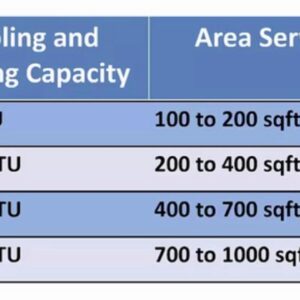Selecting the Right Capacity for Ductless Mini-Split Air Conditioning Units: A Comprehensive Guide
When considering the investment in a ductless mini-split air conditioning system, one of the pivotal decisions you’ll need to make is selecting the right capacity for your specific needs. Ductless mini-split units are known for their flexibility, efficiency, and effectiveness, making them an excellent choice for a variety of heating and cooling applications. In the United States, these units come in a range of capacities, measured in British Thermal Units (BTUs), that cater to spaces of varying sizes and purposes.
Understanding BTUs and Their Equivalents
Firstly, it’s critical to grasp the concept of BTUs. BTU, or British Thermal Unit, is a measurement of energy. In the context of air conditioning, BTUs denote the amount of heat an AC unit can remove from a room per hour. Higher BTU ratings mean greater cooling or heating capacity. For HVAC professionals, one ton of cooling capacity equates to 12,000 BTUs. Consequently, a 12,000 BTU mini-split is referred to as a one-ton system, a 24,000 BTU unit as a two-ton system, and a 36,000 BTU unit as a three-ton system.
Determining the Ideal Capacity for Your Space
Selecting the appropriate BTU capacity for your mini-split unit involves evaluating several key factors:
-
Square Footage of the Space:
- 9,000 BTU Unit: Ideal for spaces between 100 and 200 square feet. These units are best suited for smaller bedrooms and similar-size areas.
- 12,000 BTU Unit: Suitable for areas ranging from 200 to 400 square feet. Typical applications include master bedrooms, small living rooms, and kitchen areas.
- 18,000 BTU Unit: Designed for spaces between 400 and 700 square feet. These units are perfect for larger living rooms, combined living and kitchen spaces, and larger bedrooms.
- 24,000 BTU Unit: Appropriate for 700 to 1,000 square feet. Ideal applications include retail stores, office spaces, and restaurants.
- 36,000 BTU Unit: Suitable for commercial spaces larger than 1,000 square feet. These units are often used in office spaces, retail stores, restaurants, nail salons, and spas.
-
Ceiling Height:
The height of your ceiling can significantly impact your AC needs. Higher ceilings mean more air volume that needs to be cooled or heated, which might require a higher BTU capacity than standard guidelines suggest. For spaces with ceilings over 8 feet, consider increasing the BTU capacity by 10-20%. -
Number of Occupants:
Human bodies generate heat, impacting the overall load on the air conditioning system. For rooms occupied by more people, you will need to add more BTUs. A general guideline is to add 600 BTUs per additional person beyond the standard occupancy for the space size. -
Usage of the Space:
Different rooms have different heating and cooling requirements based on their use. For instance, kitchens produce more heat due to cooking appliances, thus requiring a higher capacity unit. Conversely, a rarely used guest room might need less capacity. - Climate Considerations:
Geographical location plays a crucial role in determining the appropriate AC unit capacity. Homes in hotter climates need more BTUs to maintain the same level of comfort compared to homes in milder climates. Similarly, if you experience extreme cold in winters, you may need a unit with a higher capacity for heating.
Practical Examples
Let’s delve into some practical scenarios to understand better how this works:
Example 1: Small Bedroom (150 square feet)
A small bedroom typically requires a 9,000 BTU unit. If this bedroom has standard 8-foot ceilings and is used by one person:
- Calculation: 150 square feet x 35 BTUs/square foot = 5,250 BTUs
- Selected Unit: Since the range for a 9,000 BTU unit is 100-200 sq ft, this unit is more than adequate, ensuring efficient cooling without overburdening energy use.
Example 2: Master Bedroom (350 square feet)
A master bedroom with potential for occupancy by two individuals:
- Calculation: 350 square feet x 35 BTUs/square foot = 12,250 BTUs + 600 BTUs (additional occupant) = 12,850 BTUs
- Selected Unit: Based on this, a 12,000 BTU unit would be required. However, considering additional factors such as sun exposure, you might go up slightly in capacity.
Example 3: Combined Living and Kitchen Area (500 square feet)
For a large, mixed-use space:
- Calculation: 500 square feet x 35 BTUs/square foot = 17,500 BTUs + 4,000 BTUs (for kitchen appliances and multiple occupants) = 21,500 BTUs
- Selected Unit: An 18,000 BTU unit fits comfortably within this range but adding a margin for safety makes a 24,000 BTU unit more suitable depending on exact usage patterns.
Example 4: Office Space (750 square feet)
A moderate-size office with average ceiling height and typical business hours occupancy:
- Calculation: 750 square feet x 35 BTUs/square foot = 26,250 BTUs
- Selected Unit: A 24,000 BTU unit would probably suffice. If the office sees high occupancy or significant equipment usage, a 36,000 BTU unit may be more appropriate.
Additional Considerations
While the above calculations provide a baseline, remember that other factors like insulation quality, window types, and exposure to direct sunlight also influence your BTU needs. Modern ductless mini-split systems often come with features such as variable speed compressors (inverter technology) that adapt to real-time cooling demands, which can help mitigate discrepancies from manual calculations.
Installation and Efficiency
Proper installation is essential for ensuring the efficiency and longevity of your ductless mini-split system. Here are some tips:
-
Choose the Right Location for Indoor Units:
- Install units high on the wall to ensure even air distribution.
- Ensure there are no obstructions blocking the airflow.
- Avoid locations near heat sources or direct sunlight.
-
Optimal Placement for Outdoor Units:
- Position the outdoor unit in a well-ventilated area.
- Ensure it’s sheltered from extreme weather but still has ample airflow.
- Avoid placing it near bedrooms or common areas to minimize noise disturbance.
- Regular Maintenance:
- Clean or replace filters regularly.
- Check for any obstructions in the outdoor unit.
- Schedule professional servicing annually to maintain performance and efficiency.
The Impact of Energy Efficiency
Selecting energy-efficient models is crucial for reducing operational costs and minimizing your carbon footprint. Look for systems with high Seasonal Energy Efficiency Ratio (SEER) and Heating Seasonal Performance Factor (HSPF) ratings. These ratings indicate how effectively the unit operates over an entire season.
For example, a system with a SEER rating of 20 is more efficient than one with a SEER rating of 13. Opting for ENERGY STAR-rated units can also ensure you are getting a product that meets rigorous efficiency standards.
Conclusion
Choosing the right capacity for your ductless mini-split air conditioning system demands careful consideration of several factors including space size, ceiling height, number of occupants, usage patterns, and climate conditions. Getting the capacity right is essential for achieving optimal comfort, energy efficiency, and cost savings. Utilize the range of BTU capacities available – from 9,000 BTUs for small rooms to 36,000 BTUs for larger or more demanding spaces – by aligning them with your precise needs. Proper installation and regular maintenance further ensure that your system operates efficiently and enjoys a long lifespan. With the right ductless mini-split unit, you can enjoy a comfortable indoor environment regardless of the season, making it a worthy addition to any home, office, or commercial space.


Hey people!!!!!
Good mood and good luck to everyone!!!!!